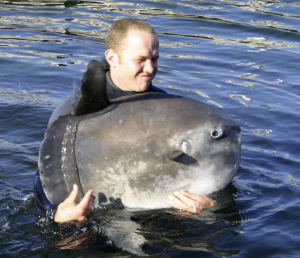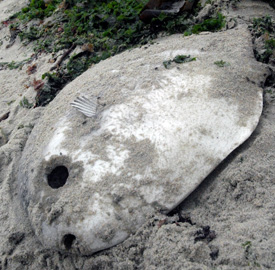
FALL 2012
In early November 2012, more than one hundred juvenile Mola mola washed up dead on the shores of Monterey Bay. Most were young of the year–40-50 cm in length–and were missing their dorsal and anal fins and eyes.The first report of 2012 came from volunteer BeachCOMBERS who reported a mola carcass on Marina State beach on October 7th. In mid-October, CSUMB students observed at least 6-12 dead/dying molas with their ROVs off Pt. Pinos. An October Big Sur subtidal survey conducted by Chad King from NOAA also observed dozens of molas being ripped apart on the surface and at least several dead/dying molas at depth.

On November 3rd, BeachCOMBERS noted 5 mola on Zmudowski Beach and in that same week more than 100 mola washed ashore between Casa Verde Beach and the commercial wharf in Monterey. On Nov. 6th two more mola were reported on the Morro Bay sand spit. In the first week of December, dozens more were reported on Aptos, Manresa and Sunset Beaches as well as Del Monte Beach and Asilomar Beach, many of which may have been remnants from the previous months’ wash-ups. Estimates of total mola carcasses along the California coast number greater than 200 individuals.
No jelly blooms were reported at this time according to jellywatch.org. However, concurrent with the mola wash up there was an incidence of Humboldt squid strandings attributed to the possible effects of a red tide. See: https://sanctuarysimon.org/site/index.php/2012/12/humboldt-squid-stranding-events-2012-2003/

FALL 2009
In October 2009, citizen scientists, BeachCOMBERS and divers reported a peak in the number of finless, eyeless Mola mola carcasses washing up on the beaches of Monterey Bay. Early sightings on Pescadero Beach were reported to oceansunfish.org on September 18. Numerous additional sightings were reported during the week of October 21 including: one on Marina State Beach, six near the coastguard pier on Oct 22 and 19 carcasses on Monterey State Beach between Seaside and Wharf 2 found on October 24th.
On October 26, seven more were reported off Point Pinos. Reports waned the following weeks with one carcass being reported off Hopkins marine station on Nov 9, one on Sunset beach, Nov 11, two on Del Monte beach, November 11, and three on Asilomar beach, Nov 18. On January 1 another carcass was reported on Monastery Beach just north of Point Lobos. All Mola mola were of similar length (between 30-60 cm) and believed to be young of the year. Most were missing dorsal and anal fins as well as eyes.

FACTS:
The giant ocean sunfish, Mola mola, is found in all tropical and temperate ocean basins. Common visitors to the California coast, giant ocean sunfish are often found in large numbers off southern California during the summer months and in Monterey Bay during the fall (September-November).
Reports of similar die-offs occurred in 1959 and 1960 (Gotshall 1961). These die-offs are due to a combination of oceanic conditions that deliver young Mola mola to nearshore waters. The role of California sea lions in the die-offs is not completely understood. The sea lions have been observed to tear off the dorsal and anal fins, toss the body across the surface of the water and then frequently abandon the fish. Although sea lions are able to puncture the intestinal cavity, the thick semi-impenetrable skin of the Mola mola often causes the sea lions to abandon the incapacitated fish–leaving it to slowly sink to the seafloor where it is consumed by seastars and other benthic scavengers.
Dr. Tierney Thys provided material for this page. Director and founder of oceansunfish.org, Dr. Thys is working with scientists from the Monterey Bay Aquarium Research Institute (MBARI) to determine what combination of oceanographic conditions contributes to such large die-offs off the California coast and beyond.
|
|